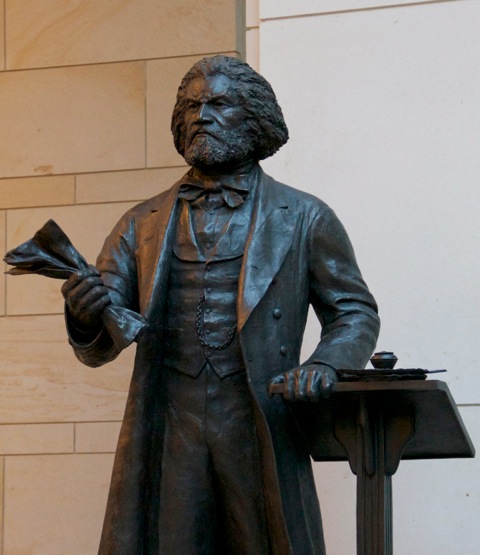Sculptor Steven Weitzman was confronted with the same, nearly impossible, challenge that artists have faced repeatedly for thousands of years: How does one capture the eternity of a subject in a single image that allows the viewer to better understand and feel the subject?
"It is hard to imagine from my perspective the insurmountable difficulties facing this man," Mr. Weitzman told me while describing the subject of his work, Frederick Douglass. "From being enslaved within a culture that aggressively supported slavery to learning to read and write, to becoming a brilliant writer, orator, statesman and counsel to President Lincoln. The profound impact this one man had on our nation didn't come to light for me until I began to research his life for this sculpture."

Photo by Steven Weitzman
Mr. Weitzman, a master of the multi-disciplinary approach to public art, is an award-winning designer of urban spaces and nationally acclaimed as an artist and sculptor. His career comprises an elite list of commissioned appointments that include the Smithsonian, United Nations, Arts Commissions and Universities across the country, a quarter of state Departments of Transportation and scores of other national clients. On June 19, his sculpture of Frederick Douglass was unveiled at the United States Capitol Visitors Center. This powerful work of art now represents the District of Columbia in Emancipation Hall.
"Months of research and no less than five professional models were used, all dressed in period clothing, some actual and some reproductions, for authenticity. The main challenge was sculpting the pose and his expression to characterize his fiery and steadfast nature."
The expression, memorialized in bronze by Mr. Weitzman, will bring Douglass' "fiery and steadfast nature" to millions of individuals in the generations to come. The expression reflects a synthesis of those emotions born from the hero's experiences: the emptiness of innocence lost prematurely, the burdensome responsibility of a young witness to atrocity, the punishing sting of tearing flesh, the revelation of freedom, the exhilaration of victory... humility and optimism -- always optimism. Most of all, the expression marks a beginning -- a point of conception from which the spirit of Douglass may live again in the hearts of the statue's viewers.
"I hope," the artist comments, "that everyone who might have an opportunity to see the work would feel the passion and conviction of this great man, which I tried to convey in the statue, and a sense of curiosity, to look deeper into who he was and what he stood for."
In the classic poem "Ode on a Grecian Urn," John Keats meditates about the idyllic pastoral scene captured upon the side of an urn and what meaning the frozen image gives to life, art and the future.
Thou, silent form, dost tease us out of thought
As doth eternity: Cold Pastoral!
When old age shall this generation waste,
Thou shalt remain, in midst of other woe
Than ours, a friend to man, to whom thou say'st,
"Beauty is truth, truth beauty,--that is all
Ye know on earth, and all ye need to know."
I understood better what Keats meant about beauty and truth when I saw the Douglass statue. What is the next big project, I asked Mr. Weitzman, you would like to take on?
"I would love to create a sculpture of President Obama."
